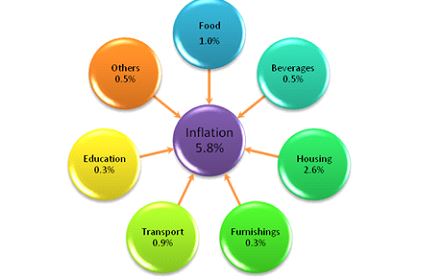
Inflation through the eyes of Kalili

FNB’s Research Manager, Strategic Marketing and Communications, Namene Kalili recently made comments on a variety of issues affecting Namibia, inflation and pricing.
Domestic inflation came in at 6.7% for April, continuing the downward trajectory from the 8.2% inflation shocker in January. Food disinflation drove overall inflation lower, printing 1.6% lower through April, from 13.2% in January.
“Food prices are not going down, but instead continue to go up. However, the pace at which food prices are increasing has slowed remarkably. A mere five months ago, food prices were rising at 13.5% per annum, but now they have come down to 5.3%. Most of this correction is attributed to increased food production in the Southern Africa, which has narrowed the excess food demand and moderated food inflation to a certain extent,” Namene said that where cereal and bread prices increased by 15.4% in January, the rate of increase has come down to 0.9% and may possibly start falling from next month onwards. Should this transpire, significant consumers of cereal and bread products will see their cost of living reduce for the first time in six years.
Other cost pressures are in housing, which accounts for 39% of the overall inflation. The combination of low housing delivery and rising utility costs, has kept housing inflation upwardly sticky. This is a situation that will persist if we do not address the structural housing supply problems, that have plagued the economy for the past decade. Whereas Windhoek has an estimated housing demand for 300 houses per month, a measly two houses were completed in Windhoek last month, one in Brakwater and another in Kleine Kuppe.
“These developments have necessitated a downward revision for our inflation expectations, we expect strong downwards trend until June, at which point, domestic cereal pricing mechanisms and new electricity tariff adjustments to lift food and housing inflation. This should stabilize inflation for the rest of the year, within the 3 to 6 percent band this year, and thus supporting our view for flat interest rates for the remainder of the year, which remains unchanged,” he added.
Regarding the petrol price hike in SA Namene advised that this was not necessarily influencing Namibia negatively. “SA has its own fuel fundamentals that drive their fuel prices. Ordinarily SA pump prices should have decreased, but the increase in road fund levies during the month resulted in increased pump prices. Back at home, fuel prices have remained unchanged, despite the under-recoveries on unleaded fuel and 500ppm diesel. Therefore, fuel prices may be adjusted in June if crude oil continues to fluctuate between U$53 and U$57 per barrel.”
In conclusion Namene stated that they expected a long drawn out recovery in the absence of fiscal and monetary buffers. “We believe the weak savings culture has made our economy too dependent on consumption expenditure for growth, while relying on external funding to finance capital investments. Therefore, increased savings and direct integration of the suppliers of capital into the capital markets will yield greater broad based equity participation, and resuscitate and sustain high growth going forward.












































